Our server will be getting a MySQL and PHP upgrade this evening between 9:00PM and 3:00AM Mountain Standard Time. There could be some down time. If all goes well it’ll be no more than 15 minutes, so start burning them offerings to the faceless numen that regulate the dark forces of server upgrades.
Month: August 2018
Third Lod mosaic found during construction of Lod mosaic museum
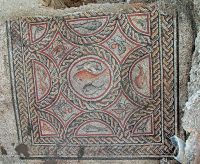 The construction of the Shelby White and Leon Levy Lod Mosaic Center, a permanent home for one the largest and most intact (not to mention one of the most beautiful) Roman mosaic floors ever discovered, has resulted in the discovery of yet another exceptional mosaic floor. Israel Antiquities Authority (IAA) archaeologists unearthed the colorful depiction of fish, birds and plants in just one month of work.
The construction of the Shelby White and Leon Levy Lod Mosaic Center, a permanent home for one the largest and most intact (not to mention one of the most beautiful) Roman mosaic floors ever discovered, has resulted in the discovery of yet another exceptional mosaic floor. Israel Antiquities Authority (IAA) archaeologists unearthed the colorful depiction of fish, birds and plants in just one month of work.
This is the third one found at the site where the first mosaic floor was found in 1996. The second was discovered in late 2014. This embarrassment of archaeological and artistic riches was once part of a large luxury home dating to the early 4th century A.D. in the ancient city of Lydda which under the Roman Empire was a district capital and important center of trade. The first and largest mosaic covered the floor of the main reception room/triclinium. The second adorned an internal courtyard. The newly-discovered mosaic covered the floor of another smaller reception room/triclinium next to the one where the largest and first mosaic was found.
“The archaeological excavation that we carried out this month was relatively small, but contributed significantly to our understanding of the villa building,” said [excavation director Dr. Amir] Gorzalczany. “Thankfully, the main central panel of the mosaic was preserved. The figures, many similar to the figures in the earlier mosaics, comprise fish and winged creatures. A fairly similar mosaic was found in the past in Jerusalem, on the Mount Zion slopes. The Lod mosaics, however, do not depict any human figures that are present in the Mount Zion mosaic. It is quite probable that the same artist produced both mosaics, or that two artists worked from a similar design.”
“This type of mosaic is better known in the Western part of the Roman Empire,” Gorzalczany explained. “Also noteworthy are the rectangular marks that may denote the placing of the couches on which the participants of the banquet or feast reclined. These marks are common in similar villas and are an indication of the use of the space in the reception halls.”
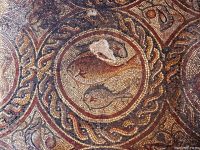 One corner of the mosaic was first spotted by archaeologists in 2014 at the time the second mosaic was discovered. Except for that one corner, the rest of the space was underneath a neighborhood parking lot and as the residents were none too keen to lose their handy spots, it took years of discussions before the mosaic could be excavated. Once the team was given the go-ahead, they had a brief window to excavate and salvage whatever they found before the property was returned to the residents.
One corner of the mosaic was first spotted by archaeologists in 2014 at the time the second mosaic was discovered. Except for that one corner, the rest of the space was underneath a neighborhood parking lot and as the residents were none too keen to lose their handy spots, it took years of discussions before the mosaic could be excavated. Once the team was given the go-ahead, they had a brief window to excavate and salvage whatever they found before the property was returned to the residents.
When the new Shelby White and Leon Levy Lod Mosaic Center opens, the first two mosaics will be displayed in situ exactly where they were found. This third one will also be on display, but not in its original location.
In this video you can see experts from the IAA salvage the mosaic, rolling it up like a carpet.
Gold trove found in ancient tomb in Kazakhstan
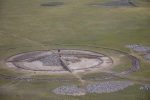 Archaeologists have discovered more than 3,000 gold ornaments in an ancient burial ground in Kazakhstan. The objects were found in a tumulus in the Eleke Sazy plateau of the Tarbagatai Mountains in eastern Kazakhstan, a site known for its 200 burial mounds of the Saka culture dating to the 8th-7th centuries B.C.
Archaeologists have discovered more than 3,000 gold ornaments in an ancient burial ground in Kazakhstan. The objects were found in a tumulus in the Eleke Sazy plateau of the Tarbagatai Mountains in eastern Kazakhstan, a site known for its 200 burial mounds of the Saka culture dating to the 8th-7th centuries B.C.
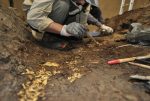 The Saka culture, a nomadic people who inhabited the Eurasian Steppe, areas of modern-day Russia, Ukraine and Kazakhstan, in the late Bronze Age and early Iron Age. The Saki were not purely nomadic. Some subgroups founded permanent settlements with large burial grounds, planted crops and mined metals. Their processing of those metals was highly sophisticated, allowing them to produce meticulously constructed jewelry and other artifacts which they traded to neighboring populations on the steppes. They also buried large quantities of them with their leaders.
The Saka culture, a nomadic people who inhabited the Eurasian Steppe, areas of modern-day Russia, Ukraine and Kazakhstan, in the late Bronze Age and early Iron Age. The Saki were not purely nomadic. Some subgroups founded permanent settlements with large burial grounds, planted crops and mined metals. Their processing of those metals was highly sophisticated, allowing them to produce meticulously constructed jewelry and other artifacts which they traded to neighboring populations on the steppes. They also buried large quantities of them with their leaders.
The artifacts unearthed in the grave are exceptional examples of Saka goldsmithing.
Among the finds are earrings in the shape of bells, gold plates with rivets, plaques, chains, and a necklace with precious stones.
Gold beads decorating clothes were made with the use of sophisticated micro-soldering techniques, indicating an exceptional level of development jewellery-making skills for the period.
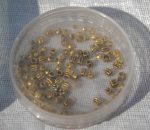 There were also gold horse fittings, spearheads and chains. Archaeologists believe the combination of jewelry and weaponry indicates the occupants of the tomb were a husband and wife couple, either rulers or at least high-ranking elite of Saka society. They can’t be sure because they haven’t even gotten to the graves yet. This immense amount of treasure was found in the excavation of the burial mound. There is likely more to be found when they reach the actual interrals.
There were also gold horse fittings, spearheads and chains. Archaeologists believe the combination of jewelry and weaponry indicates the occupants of the tomb were a husband and wife couple, either rulers or at least high-ranking elite of Saka society. They can’t be sure because they haven’t even gotten to the graves yet. This immense amount of treasure was found in the excavation of the burial mound. There is likely more to be found when they reach the actual interrals.
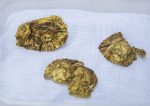 Such a rich find made after two years of excavations at the site extends hope that there are other graves of similar importance still be unearthed among the 200 known. It’s likely that the burials were plundered on a wide scale in antiquity, however, so discovering another haul of this magnitude is far from a sure thing.
Such a rich find made after two years of excavations at the site extends hope that there are other graves of similar importance still be unearthed among the 200 known. It’s likely that the burials were plundered on a wide scale in antiquity, however, so discovering another haul of this magnitude is far from a sure thing.
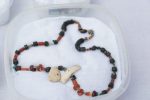 The treasures from the burial mound will be cleaned and conserved before going on display in September during the annual international archaeological conference Altai, the Golden Cradle of the Turkic World.
The treasures from the burial mound will be cleaned and conserved before going on display in September during the annual international archaeological conference Altai, the Golden Cradle of the Turkic World.
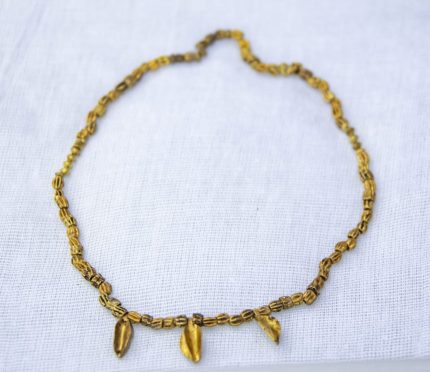
UK bars export of Dickens’ study table
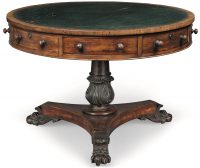 MP Michael Ellis, the UK’s Minister for Arts, Heritage and Tourism, has temporarily barred the export of an antique table not so much because of its intrinsic value, but because it was a long-time beloved companion of Charles Dickens. The piece is a gem in its own right, mind you. It’s a handsome William IV mahogany round table three and a half feet in diameter on a solid central pedestal with an acanthus collar at the base and paw feet. It was either made or sold by one M. Wilson whose name is impressed in one of the drawers.
MP Michael Ellis, the UK’s Minister for Arts, Heritage and Tourism, has temporarily barred the export of an antique table not so much because of its intrinsic value, but because it was a long-time beloved companion of Charles Dickens. The piece is a gem in its own right, mind you. It’s a handsome William IV mahogany round table three and a half feet in diameter on a solid central pedestal with an acanthus collar at the base and paw feet. It was either made or sold by one M. Wilson whose name is impressed in one of the drawers.
Estimated to have been made in around 1835, the round table has a revolving drum top above eight drawers and is covered in green leather. It was used by Dickens during most of his career – first in his London home at Devonshire Terrace; then his offices on Wellington Street where he published Household Words and All the Year Round; and finally in his library at Gad’s Hill Place in Higham, Kent where he died in 1870.
It is also known to have contained the keys to his wine cellar, and appears to be one of the very first objects to have been formally labelled with Dickens’ name; one drawer contains an oval silver plaque stating that the table stood in his library.
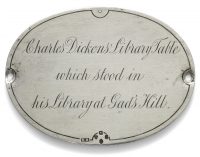 The full inscription on the silver plaque reads: “‘Charles Dickens’ Library Table / which stood in / his Library at Gad’s Hill.” It was made by Robert Hennell and his cypher dates it to 1873, just three years after Dickens’ death. While the movements of the table cannot been documented with mathematical precision, experts believe it remained at Gad’s Hill Place. Charles Dickens’ first son Charles Dickens Jr. bought Gad’s Hill at auction in 1870 after his father’s death. Financial troubles compelled him to sell the estate in 1878. His younger brother Sir Henry Fielding Dickens, a successful barrister, acquired Gad’s Hill Place and thus the table, keeping it in the family.
The full inscription on the silver plaque reads: “‘Charles Dickens’ Library Table / which stood in / his Library at Gad’s Hill.” It was made by Robert Hennell and his cypher dates it to 1873, just three years after Dickens’ death. While the movements of the table cannot been documented with mathematical precision, experts believe it remained at Gad’s Hill Place. Charles Dickens’ first son Charles Dickens Jr. bought Gad’s Hill at auction in 1870 after his father’s death. Financial troubles compelled him to sell the estate in 1878. His younger brother Sir Henry Fielding Dickens, a successful barrister, acquired Gad’s Hill Place and thus the table, keeping it in the family.
The table remained in the family by descent until it was put up for auction in December of 2017. It sold at Christie’s London for £67,600 ($88,000), apparently to a foreign buyer who applied for an export license. The independent advisory committee that reviews export requests and recommends whether the Ministry should allow or bar them determined Dickens’ table was of national importance.
Reviewing Committee on the Export of Works of Art and Objects of Cultural Interest member Christopher Rowell said:
“On one occasion, when he was abroad, Dickens precisely described this table and its position in his Library so that a friend could locate a set of keys in one of its drawers. His art criticism as well as his descriptive writing reveal his aesthetic sensibility and this elegant, if workmanlike, leather-covered mahogany library table was clearly valued by him. Its associations are of considerable interest to lovers of Dickens’ novels and writings.”
The status of the table will be in limbo until October 26th, 2018. If a party shows serious intent and ability to raise the necessary funds to reimburse the purchase price, that deadline could be extended to January 26th, 2019.
Rare dog sarcophagus rescued from museum pound
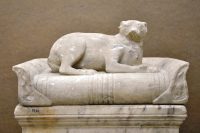 The National Archaeological Museum in Athens has pulled a once-beloved dog from storage and put it on display for the first time since it was discovered 81 years ago. The small sarcophagus adorned with a sculpture of a pet dog dates to the mid-3rd century A.D., the Roman period. It was unearthed in 1937 on the north side of the National Garden in downtown Athens. The ancient Greek road from Athens to Mesogeia, the interior region of the Attic peninsula, ran along what is now Vasilissis Sophias Ave, the north border of the National Garden. As we know, Romans often used the road out of town was for burials, and while no other wee dog sarcophgi have been found in this area, excavations done during construction of the subway station at Syntagma Square just a couple of blocks away did reveal other Roman-era animal graves.
The National Archaeological Museum in Athens has pulled a once-beloved dog from storage and put it on display for the first time since it was discovered 81 years ago. The small sarcophagus adorned with a sculpture of a pet dog dates to the mid-3rd century A.D., the Roman period. It was unearthed in 1937 on the north side of the National Garden in downtown Athens. The ancient Greek road from Athens to Mesogeia, the interior region of the Attic peninsula, ran along what is now Vasilissis Sophias Ave, the north border of the National Garden. As we know, Romans often used the road out of town was for burials, and while no other wee dog sarcophgi have been found in this area, excavations done during construction of the subway station at Syntagma Square just a couple of blocks away did reveal other Roman-era animal graves.
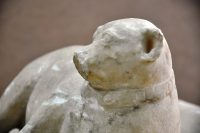 The dog sits on the lid of the sarcophagus, his front legs crossed in a dignified posture, comfortably ensconced on his plush striped bed. His collar is studded with gemstones — circles, squares and diamond-shaped — and a bell hangs from a loop in the front. The collar, bedding and bell unmistakably identify the dog as somebody’s cherished pet rather than a symbolic representation of a deity or a funerary sacrifice.
The dog sits on the lid of the sarcophagus, his front legs crossed in a dignified posture, comfortably ensconced on his plush striped bed. His collar is studded with gemstones — circles, squares and diamond-shaped — and a bell hangs from a loop in the front. The collar, bedding and bell unmistakably identify the dog as somebody’s cherished pet rather than a symbolic representation of a deity or a funerary sacrifice.
Funerary monuments to dearly departed dogs are unusual but not unheard of in the Roman archaeological record. Most of them are stele engraved with just an inscription and sometimes a low relief of the animal and an inscription clearly identifying them as grave markers for the pet. The British Museum has a wonderfully expressive example of a marble epitaph plaque inscribed with a poem written from the perspective of the dog who was buried under it.
Gaul gave me my birth and the pearl-oyster from the seas full of treasure my name, an honour fitting to my beauty.
I was trained to run boldly through strange forests
and to hunt out furry wild beasts in the hills
never accustomed to be held by heavy chains
nor endure cruel beatings on my snow-white body.
I used to lie on the soft lap of my master and mistress
and knew to go to bed when tired on my spread mattress
and I did not speak more than allowed as a dog, given a silent mouth
No-one was scared by my barking
but now I have been overcome by death from an ill-fated birth
and earth has covered me beneath this small piece of marble.
Margarita [“Pearl”]
 Animal figures have also been found on the funerary reliefs of children, see for example this sweet memorial to “To Helena, foster daughter, the incomparable and worthy soul,” at the Getty.
Animal figures have also been found on the funerary reliefs of children, see for example this sweet memorial to “To Helena, foster daughter, the incomparable and worthy soul,” at the Getty.
Complete three-dimensional sculptures of dogs on sarcophagi are a horse of a different color. They are so rare that only one other example has been found on the Attic peninsula. It too is in the collection of the National Archaeological Museum, but it’s still in storage.
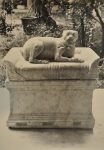 The marble pooch was rescued from the pound on Monday and will be on display through October 21st only.
The marble pooch was rescued from the pound on Monday and will be on display through October 21st only.
A selection of artifacts from the museums store rooms have been placed on display for the Unseen Museum exhibition, each for a period of two months. The particular artifact complements the temporary exhibition “Hadrian and Athens: Conversing with an Ideal World” that opened on November 27 and will run for a year.
In August and until October, museum archaeologists will conduct tours for visitors that focus on the habits of ancient Athenians, including their strong ties to pet animals. These will be held on three Sundays (August 19, September 16 and October 21) and two Fridays (September 14 and October 19), starting at 13:00. To attend the presentations, visitors must first obtain a ticket on arrival.